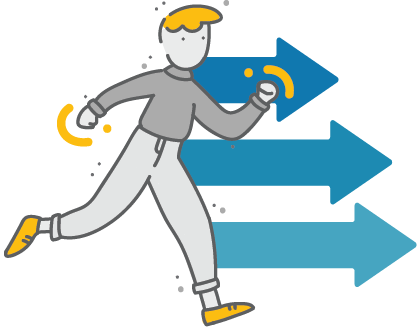Returning to Work
Job Accommodations for Concussion
Updated Jul 29, 2019
Swipe right to go to the next slide
A job accommodation is a change to your regular work role that makes it possible to return to work when you still have some symptoms. This can include changes to your hours (e.g., a gradual return to work); changes to your work environment (e.g., a private workspace); changes to your work duties (e.g., reassignment to less computer-based tasks); and many other possible changes depending on your needs. These changes are typically temporary while you build tolerance after your concussion.
The range of possible job accommodations is as broad as all the kinds of jobs that exist. Think about how the interaction between your symptoms, work environment and job duties will impact your functioning. Also consider what activity modifications have worked for you so far to make it easier to do the everyday things you need to do. The same strategies that work elsewhere will likely also help at your job.
Examples discussed in this article do not include every possible accommodation - and not everyone will need all the accommodations listed here! Use your imagination and try to picture what changes would make it possible for you to do your job.
Some general job accommodations will be quite obvious. One example would be an accommodation to take scheduled rest breaks throughout the day, in addition to your lunch break and regular coffee breaks. Early on in your return to work, you may need an accommodation for frequent rest breaks (e.g., a 10-minute break every hour).
Other general accommodations include:
In addition to the general accommodations, your family doctor can recommend specific accommodations that temporarily change your actual job duties or requirements.
Examples include:
In some cases, simple changes to the environment can have a major impact on your work productivity. Environmental accommodations include access to:
One added benefit of environmental changes is that they often don’t require a formal accommodation. Creating a quiet workspace can be as simple as closing the door and putting up a “do not disturb” sign while completing complex tasks. Access to a quiet space for breaks is another basic environmental accommodation.
Affordable technologies can also support productivity during recovery. Some examples are:
While some technology-based solutions may require a formal accommodation, many do not. Try adjusting your monitor’s brightness/contrast settings or font size to reduce eye strain. Turning off the pop-up notifications for emails can limit distractions.
Take a look at the sample workspace on the right.
Click on the image to see it in full-screen mode. Then, click on the yellow dots to see some accommodations you could make in your workspace.
To get a better sense of what temporary job accommodations could look like in practice, consider the following examples.
Cashier/Salesperson
This role typically works in a retail setting and provides customer service and cash-handling. Most Sales positions are fast-paced and require a lot of interaction with people.
Possible Accommodations:
Administrative Assistant
This role typically involves mostly computer-based tasks and often works in a shared-space (e.g. cubicle) setting. Most Admin tasks have deadlines and require high attention to detail.
Possible accommodations:
Tradesperson/Labourer
This role typically involves fast-paced, physically demanding tasks in both indoor and outdoor settings. Most Trades roles also require technical expertise and attention to detail.
Possible Accommodations:
Based on what you have learned about Job Accommodations, you may want to write a list of the job tasks you feel will be challenging given your current symptoms and abilities.
Writing a list will help you assess your current readiness for work, and can also help your doctor make recommendations for job accommodations.

Click the button above to toggle between light mode and dark mode. This toggle can also be found in the menu.
Hold
and tap
to zoom in.
Hold
and tap
to zoom out.
Hold
and tap
to zoom in.
Hold
and tap
to zoom out.
On most mobile devices, you can spread to zoom.
Increase your text size in your device settings.
Remember to take regular breaks while exploring MyGuide: Concussion.
Vancouver Coastal Health’s MyGuide Concussion Team would love to hear your feedback! It matters to us and helps to improve the experience for future users. Your responses will be kept anonymous and your privacy is a top priority. To complete a 15-20 minute online survey or request a telephone survey, please click the link below.